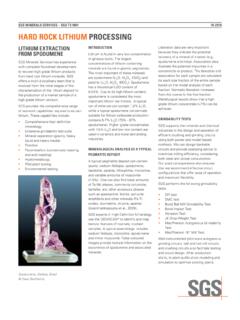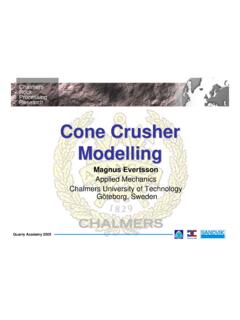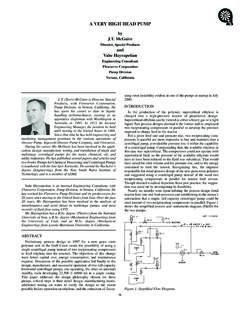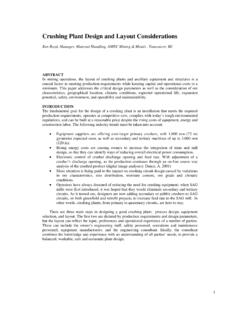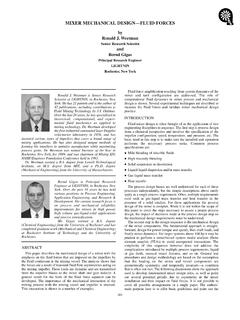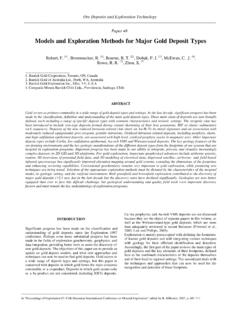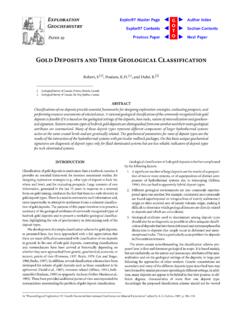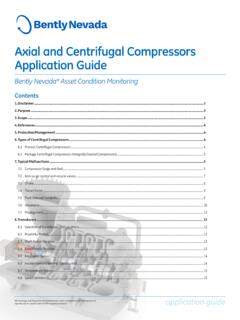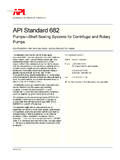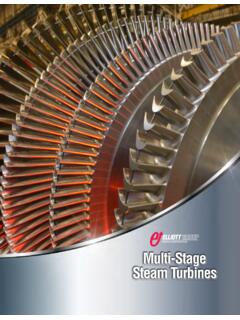Transcription of MATERIAL SELECTION FOR MECHANICAL SEALS
1 Michael B. Huebner is a Staff Engineerinthe Flow Solutions Division ofFlowserve Corporation, in Deer Park,Texas. He has more than 20 years experi-ence in the design of MECHANICAL SEALS , centrifugal and positive displacementpumps, and fluid conditioning Flowserve, he has served in design,testing, and application functions in boththe and Huebner received his degree(Engineering Technology) from Texas A&M University. He is amember of the International Pump Users Symposium AdvisoryCommittee and the API 682 Task SEALS are used throughout industry to minimize oreliminate leakage in centrifugal pumps, mixers, and other rotatingequipment. The ability of a MECHANICAL seal to meet its performanceobjectives depends upon a wide range of factors involving equipmentdesign, operating conditions, and support systems.
2 Included in thislist is the SELECTION of the materials of construction of the SEALS are constructed of a wide range of materialsincluding metals, elastomers, and ceramics. Each of thesematerials plays an important role in the operation of the seal . Sealmanufacturers have narrowed the list of available materials throughyears of successful field experience. Still, the SELECTION of thecorrect materials remains a critical step in the successful applica-tion of a MECHANICAL BASICSA MECHANICAL seal is a device used to seal the interface betweenarotating shaft and a stationary housing (Figure 1). This iscommonly seen in centrifugal pumps although this challenge alsoexists in other equipment such as agitators, turbines, compressors,centrifuges, and blowers. The MECHANICAL seal has gained successover the years due to its ability to minimize or eliminate leakage ofprocess fluids to atmosphere.
3 This has resulted in improvedequipment reliability, reduced emissions, and improved 1. Typical MECHANICAL the purpose of a seal appears deceptively simple, thedesign of seal components is a significant engineering challenge. Tominimize leakage, the rotating and stationary sealing interface isnormally separated by a very small film. This film is on the order of20 millionths of an inch (or a half micron). With the seal facesoperating this close together, there is some level of contact thatresults in wear and heat generation. In balancing the requirementsof low leakage and low wear, the SELECTION of materials becomesimport. It is important not only to the seal faces but to all of thecomponents in a seal that contribute to its ability to maintain anacceptable fluid film.
4 In this paper the author will divide the sealinto three major categories of components: the seal faces, secondarysealing elements, and major metal components (Figure 2).Figure 2. Major seal faces are the elements that define the sealing seal face will be mounted onto and rotating with the shaft. Theother seal face will be mounted into and stationary with the seal faces must allow for rotation as well as other motionsexperienced in the pump. Since all equipment has some smallamount of misalignment, run-outs, and clearances, the seal facesmust be capable of both axial and radial motions to maintain aneffective fluid the seal face may be the heart of the seal , secondarysealing elements or gaskets can create their own challenges thataffect seal performance.
5 Secondary SEALS perform the function ofsealing between internal seal elements as well as sealing betweenthe MECHANICAL seal and the pump. Most secondary SEALS are staticmeaning that there is no relative motion between the sealed com-ponents. In a pusher type seal , there is also a dynamic gasket thatmust allowfor small amounts of axial motion to compensate forequipment motion and wear of the seal last major category is the metallic components used in amechanical seal . This includes materials for the sleeve, gland, andsprings. It also includes a more challenging duty in the materialsused in welded metal bellows. Welded metal bellows act as both aspring and an expansion joint and eliminate the need for a dynamicgasket. The requirement for motion and pressure containmentmakes the SELECTION of bellows MATERIAL challenging.
6 Welded metal127 MATERIAL SELECTION FOR MECHANICAL SEALSbyMichael HuebnerStaff EngineerFlowserve CorporationFlow Solutions DivisionDeer Park, Texasbellows must be easily welded, have good physical properties, andbe resistant to most types of FacesThe seal faces of a MECHANICAL seal provide a demanding set ofrequirements for a seal designer. The faces must be stable, conductheat, be chemically resistant, and provide good wear characteris-tics. They must also be easy to manufacture, readily available, andeconomically priced. In the early years of MECHANICAL SEALS , someseal faces were manufactured from metals such as hardened steels,copper, and bronze. This has evolved over time as newer, moreexotic materials have been developed including ceramics andvarious grades of MECHANICAL paper will review some of the most common seal facematerials.
7 These include MECHANICAL grades of carbons as well asthe most popular ceramics. This list does not include every materialever used as a seal face. Some materials such as overlays orhardened metals that were widely used in the past have been con-sidered obsolete for years. Surprisingly, some of these options areresurfacing in specialty applications where their strengths areexploited. Other materials such as diamond coatings and siliconnitride are also used in specialty applications and are beyond thescope of this is one of the most abundant elements on earth. It is thebasis for all organic products and processes. It is also an interest-ing MATERIAL because it takes on forms from amorphous carbon tographite to diamonds to fullerenes. Carbon is inert, stable, and canbe self-lubricating.
8 It is used in products as varied as pigments,carbon black in rubbers, and electrical brushes. It can take the formof soft carbon graphite powder to hard friction carbons used in seal faces are a mixture ofamorphous carbon and graphite. The percentages of each helpdetermine the physical properties on the final grade of carbon. Inaddition to carbon, other elements and compounds are present thataffect the properties of the grade of carbon. Some of these areimpurities from the original sources of carbon; others are specifi-cally added to improve some aspect of the carbon s carbons aremanufactured by blending togethertypes of amorphous carbon ( ,lampblack,charcoal, or coke) andcarbon graphite with a carbonaceous binder ( , pitch or resins).The source of the raw materials not only helps determine thephysical properties of the carbon but also the type and amount ofimpurities.
9 Other additives will be blended in depending upon thespecific grade. The mixture is then pressed into shapes and heatedin an inert environment. At a high temperature, most of the binderdecomposes into carbon while a small amount volatizes and leavesthe part. This leaves the carbon porous and carbon is then placed into a vacuum chamber to remove anyair from the porous carbon. While under a vacuum, the carbon isimmersed into liquid impregnant. The vessel is then pressurized todrive the impregnant into the carbon. This effectively fills the poresof the carbon making it impermeable and greatly increasing thestrength of the final MATERIAL . The SELECTION of impregnants is acritical factor in determining the properties of the final include various plastics and resins, metals, and most common impregants for MECHANICAL seal faces arethermoset resins and antimony metal.
10 While a carbon manufacturermay produce hundreds of grades of carbons, the MECHANICAL sealindustry has standardized on only a dozen or so grades that areused for the majority of seal applications. With the consolidation ofcompanies in the carbon manufacturing business, the list is Impregnated CarbonAs the name implies, resin impregnated carbon is a mixture ofamorphous carbon/graphite that has been impregnated with athermoset resin. This is by far the most common type of carbon formechanical SEALS used in industry today. While there is a widevariety of specific formulations or grades available, most resinimpregnated carbons are capable of operating in a wide range ofchemicals from strong bases to strong acids. They possess goodfrictional properties and an adequate modulus to help controlpressure ImpregnatedMetallized carbons are available with a variety of metal impreg-nants including copper, bronze, lead, and antimony.
